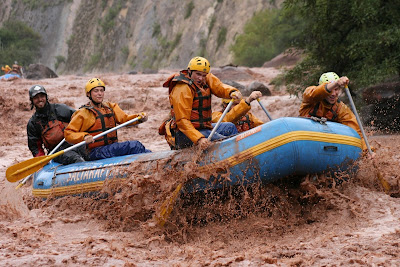 Hello everybody from Peru! I hope you all had a great Easter! I certainly did as I continued my journey through Latin America throughout Bolivia and into Peru.
Hello everybody from Peru! I hope you all had a great Easter! I certainly did as I continued my journey through Latin America throughout Bolivia and into Peru.I have just arrived in Peru today and am currently in the Southern town of Puno on the shore of Lake Titicaca. To be honest the town is not the nicest place, and tomorrow I get on a bus and head to Cusco where I stay for a few days before I begin my Inca Trail. I think Puno looks slightly worse than it probably is largely because I have just come from the Bolivian town of Copacabana on the Southern shore of Lake Titicaca. It is a great town in it's own right as well as the port for ferries heading to the Inca ruins on the islands of Isla del Sol and Isla del Luna on the Lake. I spent a day walking around Isla del Sol looking at some of the Inca ruins (The Inca's believed the island was the birth place of the sun god) which has really made me begin to look froward to Macchu Pichu in the next few days.
Aside from Copocabana I have spent the rest of my time since my last post in La Paz. In many ways I was suprised at how much I liked La Paz. I was not expecting it to be that great, but what I found was one of my favorite city's of the trip so far. The only reason I had planned to stay so long was because I did not want to be stuck in some village in Bolivia during Easter, but what I found was a vibrant and fun city and one of the best places to go out in the entire of my trip so far (it may have helped that I was staying in a brewery).
The city itself is the highest capital in the world and yet sits spectacularly in a valley surrounded by snow capped peaks which the houses climb up. The city is also the base for the popular 'world's most dangerous road' mountain bike trip. I decided to do the trip thinking the name was exaggerated slightly. The reason the road (going from La Paz to Coroico) was named such was because on average it used to have 100 deaths a year largely due to bus crashes. However the Bolivian government finally worked out that it might be sensible to open up an alternative route linking the to towns to stop this, meaning that the only cars that now use the road are those people that live on the road itself. The road is a 40km long 3m wide gravel (loose gravel as I found out!) track that descends 3000m. It is covered in waterfalls and lanslides and has an exceptionally high drop off the side (about 2 bikers die every year going off the side) so obviously I had to bike down it. It is very hyped and thousands of tourists do it every year unharmed, but while deaths are rare, apparently broken bones are not uncommon. I can see why. I had the misfortune of skidding on one corner, known by the guides as 'collar bone corner' and coming off the bike (fortunately) onto the road. I escaped with merely scrapes and bruises, although one bruise does cover my entire left hip area and I have an impressive limp at present. However I carried on and made it to the bottom alive.
Speaking to my guide at the end of the ride I was told by him that accidents are not uncommon largely due to blokes riding too fast (guilty!) girls riding too slow. He then told me that he himself was not immune to this and had been off the edge, but had fortunately only fallen 3m into a tree and not 400m. Maybe the name 'the world's most dangerous road' is appropriate.
Anyway I best be off to bed now as I have a ridiculously early bus to Cusco tomorrow morning. I will speak to you all soon.
Phil

 Hello everyone and welcome to the latest post on my blog.
Hello everyone and welcome to the latest post on my blog.

